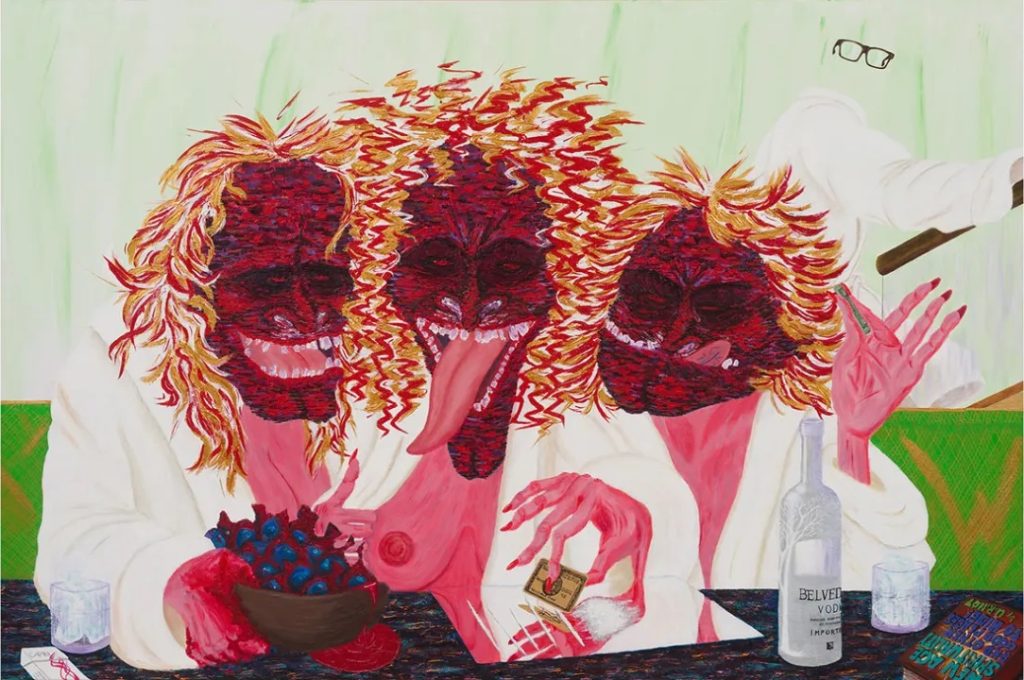Renowned for his unmatched comic and acting skills, Jim Carrey has enthralled audiences for many years with his captivating performances and enduring characters. But Carrey has just taken up painting, a new artistic endeavour that has attracted much interest and appreciation. This introduction looks at how art changed Carrey’s life and examines the sources of inspiration for his colourful and provocative artwork. We discover a very intimate and passionate side of Carrey when we move from the screen to the canvas, highlighting his creative process’s complexity.
Jim Carrey’s works have drawn the interest of art enthusiasts and the professional community in and out of the movie industry. Carrey has shared his artwork across various platforms, earning recognition for the intensely intimate nature of his works. Carrey explores current topics and personal thoughts in his artwork, which ranges from political cartoons to spiritual landscapes, which puts him at the centre of contemporary social criticism. Furthermore, it shows how seriously he took his second career as a visual artist when he decided to turn the pool house in his Brentwood property into an art studio. Carrey’s involvement in art marks a pivotal era in his life—as much an identity as his iconic film roles, even though some celebrities may consider art a hobby.
Art of Jim Carrey
Jim Carrey’s influence in the arts goes beyond his well-known roles as an actor and comedian. Carrey has gained recognition and admiration as a significant visual artist within the last ten years. Carrey resorted to sculpting and painting to express himself and find solace. He has demonstrated the healing potential of creativity by being transparent about his use of painting as a coping mechanism for personal struggles and depression. Bold brushstrokes, vivid colours, and frequently humorous and surreal subjects define Carrey’s artwork. His unique take on life and society is reflected in his works, which combine aspects of political satire, expressionism, and pop art.
Jim Carrey’s artwork embodies deep themes entwined with vibrant emotion, going beyond the casual celebrity dabbling. Via various visual techniques, he channels his ideas on politics, personal identity, and the human condition via his art, which includes various themes and genres. His politically charged cartoons, which frequently mock public figures such as Donald Trump, have generated conversations and debates, proving the importance of art in political discourse. Using his position to spread awareness and spark discussion, he also uses his work to address more general social issues, including human rights, environmental degradation, and gun violence.
“Jim Carrey: I Needed Colour,” a documentary, explores his artistic career and offers insights into his inspirations and methods. His breadth as an artist has been highlighted by this film, which has exposed his work to a broader audience. His talent and perseverance have won him respect, demonstrating that originality has no bounds in standard career paths.

Regarding his painting from 2016, “I do a lot of Christ,” he remarks. However, I don’t consider it from a Christian perspective. I intended to depict Christ’s awareness emerging somewhat from thin air. Jim Carrey remarked, “And you could find every race in his face.” Carrey depicts his interpretation of the well-known religious figure in “Jesus,” giving the painting vivid hues and expressive brushstrokes. This piece of art perfectly captures Carrey’s audacious and dynamic approach to utilising art to express more profound ideas and elicit contemplation. Many believe that Carrey’s portrayal of Jesus in his art mirrors his spiritual development and search for purpose.
Even though Carrey has primarily used social media to discuss Trump, he occasionally uses the platform to comment on other topics. He shared a drawing of the troubled comedian Bill Cosby on April 28 along with the warning, “Beware of false prophets, who come to you in sheep’s clothing but are ravenous wolves on the inside — Matthew 7:15.” Carrey’s portrayal of Cosby is a component of his larger body of politically and socially charged art, which reflects Carrey’s candid personality and opinions on a range of topics. Carrey plays Cosby in this performance, emphasising the accusations and problems surrounding the comic. In an attempt to express Carrey’s dissatisfaction as well as the general public’s feelings about Cosby’s legal issues and the allegations of sexual assault, the artwork is stark and bold.
The “Eva” artwork by Jim Carrey demonstrates his unique and dynamic style, which combines vivid colours and forceful brushstrokes to evoke depth and emotion. The work highlights his viewpoint, frequently combining reflection and social criticism themes. Carrey’s evolution from a celebrated actor to a reputable visual artist enabled him to use his paintings to investigate and convey complex concepts; hence, “Eva” represents his changing artistic direction.
No Vacancy is one of Carrey’s early works, completed in 2012. “Until a few years ago, I didn’t put my paintings up,” explains the artist. “I kept them hidden. I’m not sure why precisely, but I thought neither I nor they were good enough, and nobody would want to see my paintings on the walls.” The picture depicts a chaotic, vibrant landscape with abstracted objects and individuals that suggest crowding and a lack of room. “No Vacancy” implies a vast globe, maybe to the extent of being oppressive or uninviting.
Carrey’s backyard is now centred around Ayla. He remarks that when a full moon reflects off her eyelashes, her eyes open, implying that “she’s basking in the moonlight, and she holds all of the magic and power of the universe in her head.” “On full moon nights, she wakes up.”Since Carrey has produced several works under “Ayla,” particular details may differ depending on the discussed piece. His work is often dynamic and strange, using solid colours and brushstrokes. His writing can arouse intense feelings and cause one to reflect on the nature of reality, existence, and the self.
The caption for his February 2018 sketch of a little victim of a school massacre said, “Oh Say, Can’t You See?!” “Can’t You See?” is one of his well-known works that probably examines perspective and perception, potentially pushing viewers to reconsider their perceptions and understandings. Carrey’s genuine examination of existential issues and human experiences throughout his shift from acting to visual art has distinguished his adaptability and inventiveness outside the entertainment sector.

“Space Wars” delves into space-related subjects by fusing Carrey’s trademark comedy with a cosmic, occasionally surreal visual. Carrey’s artistic endeavours frequently showcase his contemplative and intellectual side, providing an insight into his artistic escapades beyond the performing arts. His “Space Wars” compositions can inspire awe, humour, and perhaps a deeper reflection on what it means to be human in the grandeur of the cosmos.
A parody of Trump policy advisor Stephen Miller was tweeted on June 17 with the following caption: “Evil is pushing the boundaries, sanctioned, embraced, and normalised by POTUS.” The sociopaths are now at the top. We will kidnap kids from their families at our border on Father’s Day because the GOP is unaccountable, and Stephen Miller didn’t live up to his father’s expectations. According to others, “Who Killed The Cat” is a satirical commentary on societal concerns that uses vivid colours and strong images to get its point across. Carrey’s move into visual art has aroused conversations concerning celebrity artists and the relationship between notoriety and artistic expression. His pieces, such as “Who Killed The Cat,” are examined and valued for their complexity and creative value.
Carrey completed The Prison of Becoming in 2015. He states in the composition, “The butterfly that settles on your finger symbolises presence. He was released from the jail of becoming at that very moment, for most of us are always trapped in a prison of who we will be, how things will turn out, and how we will get things done. If I hadn’t done it, I could have completed the task. I regret doing it. The adversary is that time travel. The jail of becoming, then.”
Conclusion
Jim Carrey’s foray into painting is more than a famous hobby; it’s a severe investigation of expression and creativity. Carrey has established himself as a serious artist by defying expectations, from his early sketches to his vivid and thoughtful paintings today. His paintings provide insights into his mind, exhibiting a fusion of gloom, comedy, and contemplation reminiscent of his diverse entertainment career. Whether you are drawn to Carrey’s vibrant abstractions or his moving portraits, his work challenges spectators to consider the intricacies of life and the human condition. Jim Carrey pushes us to reevaluate the limits of creativity and the potential of artistic reinvention as he develops as an artist.
What Makes Grandma Moses’ Folk Art and Paintings So Beloved and Timeless?





